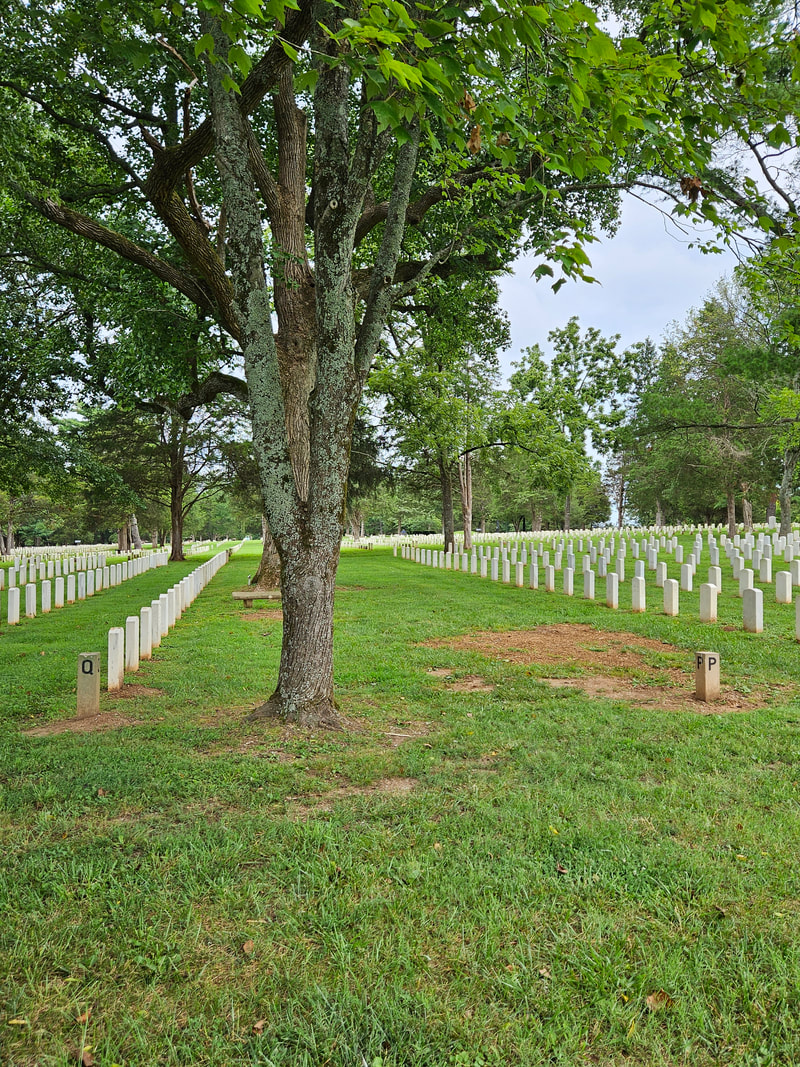A Story of Segregation by Thomas Zei
|
One of the shameful stories in Stones River National Cemetery is hidden in Sections P and Q. Although not overtly displayed on the headstones or in cemetery records, the story would be apparent if you could time travel back a century. On any given day, a visit to the cemetery could have you viewing a policy in effect there.
If you could be there, it was possible to come upon two funerals happening at the same time. What you would observe, the funeral occurring in Section P would have mourners who were all White. As your eyes move to the funeral underway in Section Q, you would find that the family members were all Black. Although each burial was for a veteran who served in a foreign battlefield, the practice of segregation in the armed forces was the national policy until an executive order signed by President Harry Truman on July 26, 1948 halted it. Even though segregation was stopped in the military with the motion of his pen, the policy did not carryover to the national cemeteries, especially in the South or in those cemeteries under the control of the National Park Service. To find out how we got to this point at Stones River National Cemetery, we need to step further back in its history. The cemetery was designed to accommodate 8,000 graves based on an estimate provided by the Quartermaster of Union soldiers who died within the original area of responsibility, which included all of Middle Tennessee along the railroad line running from the towns of La Vergne to Cowan, TN. This number ended up being closer to around 5,100. When the decision was made to move the Union dead from Rose Hill Cemetery in Columbia, TN to Stones River, the number of burials increased to about 6100 graves. The War Department created a policy to allow the burial of soldiers who died on foreign soil as well as veterans who served in wars on foreign soil into existing and new national cemeteries. For Stones River National Cemetery, space was readily available within the stone walls of the grounds. Two new sections were created in front of Section I, the so-called Franklin Section containing the remains of soldiers who died in Franklin, TN, especially in the November 1864 Battle of Franklin. These two sections were designated P and Q. [Note: The original design of the cemetery shows one large section containing almost 800 grave sites. This large section was designated as Section P. The decision was made at the onset to bury the White veterans at the top of the section while burying the Black veterans in the lower part of the section which was prone to flooding. This separation later was made permanent by the creation of Section Q. For simplicity, this lower part is referred to throughout this story as Section Q even though the name did not come until later.] Sections P and Q continued the existing segregation policies in the military that started during the Civil War after the Emancipation Proclamation and later Jim Crow era laws, prevalent throughout the South. Section P was designated for veterans that were White while Black veterans were required to be buried in Section Q. Thus, your journey back in time would show the segregation policy playing out in front of you. Although a term from those using printing presses, it became equally important to the grave diggers at Stones River “to mind your P’s and Q’s” when planning for the next burial. So, when and why did segregated burials end? Part of the reason for ending the policy came about just because of necessity. Section P, with 300 graves, was designed smaller than Section Q with 400 graves. The carriage lane separating the two sections does not match up with any other lanes so it could have been placed to more equally balance the sections. This imbalance occurs despite the probability that the number of eligible White veterans outnumbered the eligible Black veterans. Section P was basically filled to capacity early in 1965 while there were still many graves available in Section Q. Superintendent Lawrence Quist did not want to open up any new sections until these sections were completed. He ended the segregation policy and both Blacks and Whites were buried in the remaining open graves in Section Q. This time period also coincided with the passage of The Civil Rights Act of 1964 ending most segregation in the U.S. This legislation probably was a factor in the superintendent’s decision in ending the segregation policy as the country moved away from Jim Crow laws, although many policies were still prevalent for years to come. The Southeast Region of the National Park Service also formally ended all segregation policies in the national cemeteries under its control at a later date. Although these actions stopped the continual discrimination, it unfortunately could not change the scars of segregation already etched in the grounds of the cemeteries. It is important for us to continue telling the history found in Sections P and Q. |

